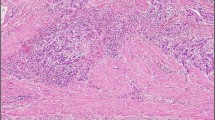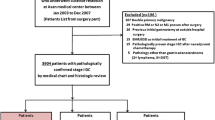Abstract
Gastric cancer can be classified into three subgroups according to pattern of tumor infiltration into the surrounding tissue: INFa (expanding growth and a distinct border with the surrounding tissue), INFc (infiltrating growth and an indistinct border with the surrounding tissue), and INFb (in-between a and c). How the tumor infiltration pattern (INF) relates to prognosis and type of recurrence in advanced gastric cancer has not been sufficiently explored. We examined 805 consecutive advanced gastric adenocarcinoma patients who underwent curative gastrectomy at our institution between 1980 and 2005. Poor differentiation, serosal invasion, and lymph node metastasis were significantly more frequent in patients with INFc tumors than in those with INFa/b tumors. For patients with a T2 or T3 tumor, there was no significant difference in prognosis between those with INFa/b and with INFc. However, for patients with a T4a or T4b tumor, the prognosis of those with INFc was significantly worse than that of those with INFa/b. In multivariate analysis, INF was an independent prognostic indicator in T4a but not T2, T3, and T4b. Furthermore, the prognosis of T4 patients with INFc tumors was significantly worse than that of those with INFa/b, especially in node-negative but not in node-positive cases. In patients with a T4a or T4b tumor, peritoneal recurrence was significantly more frequent for those with INFc than for those with INFa/b. Our data indicate that INF is useful to predict the prognosis and recurrence pattern in T4a node-negative gastric cancer.




Similar content being viewed by others
References
Jemal A, Bray F, Center MM, Ferlay J, Ward E, Forman D (2011) Global cancer statistics. CA Cancer J Clin 61:69–90. doi:10.3322/caac.20107
Bozzetti F, Bonfanti G, Morabito A, Bufalino R, Menotti V, Andreola S, Doci R, Gennari L (1986) A multifactorial approach for the prognosis of patients with carcinoma of the stomach after curative resection. Surg Gynecol Obstet 162:229–234
Adachi Y, Mori M, Maehara Y, Sugimachi K (1994) Dukes's classification: a valid prognostic indicator for gastric cancer. Gut 35:1368–1371
Siewert JR, Bottcher K, Stein HJ, Roder JD (1998) Relevant prognostic factors in gastric cancer: ten-year results of the German Gastric Cancer Study. Ann Surg 228:449–461
Joypaul BV, Hopwood D, Newman EL, Qureshi S, Grant A, Ogston SA, Lane DP, Cuschieri A (1994) The prognostic significance of the accumulation of p53 tumour-suppressor gene protein in gastric adenocarcinoma. Br J Cancer 69:943–946
Gomyo Y, Ikeda M, Osaki M, Tatebe S, Tsujitani S, Ikeguchi M, Kaibara N, Ito H (1997) Expression of p21 (waf1/cip1/sdi1), but not p53 protein, is a factor in the survival of patients with advanced gastric carcinoma. Cancer 79:2067–2072
Mori M, Kakeji Y, Adachi Y, Moriguchi S, Maehara Y, Sugimachi K, Jessup JM, Chen LB, Steele GD Jr (1993) The prognostic significance of proliferating cell nuclear antigen in clinical gastric cancer. Surgery 113:683–690
Shino Y, Watanabe A, Yamada Y, Tanase M, Yamada T, Matsuda M, Yamashita J, Tatsumi M, Miwa T, Nakano H (1995) Clinicopathologic evaluation of immunohistochemical E-cadherin expression in human gastric carcinomas. Cancer 76:2193–2201
Katano M, Nakamura M, Fujimoto K, Miyazaki K, Morisaki T (1998) Prognostic value of platelet-derived growth factor-A (PDGF-A) in gastric carcinoma. Ann Surg 227:365–371
Japanese Gastric Cancer Association (2011) Japanese classification of gastric carcinoma: 3rd English edition. Gastric Cancer 14:101–112. doi:10.1007/s10120-011-0041-5
Nagafuchi A, Takeichi M (1988) Cell binding function of E-cadherin is regulated by the cytoplasmic domain. EMBO J 7:3679–3684
Nigam AK, Savage FJ, Boulos PB, Stamp GW, Liu D, Pignatelli M (1993) Loss of cell-cell and cell-matrix adhesion molecules in colorectal cancer. Br J Cancer 68:507–514
Hinck L, Nathke IS, Papkoff J, Nelson WJ (1994) Dynamics of cadherin/catenin complex formation: novel protein interactions and pathways of complex assembly. J Cell Biol 125:1327–1340
Yoshiura K, Kanai Y, Ochiai A, Shimoyama Y, Sugimura T, Hirohashi S (1995) Silencing of the E-cadherin invasion-suppressor gene by CpG methylation in human carcinomas. Proc Natl Acad Sci U S A 92:7416–7419
Kanai Y, Ushijima S, Hui AM, Ochiai A, Tsuda H, Sakamoto M, Hirohashi S (1997) The E-cadherin gene is silenced by CpG methylation in human hepatocellular carcinomas. Int J Cancer 71:355–359
Oka H, Shiozaki H, Kobayashi K, Tahara H, Tamura S, Miyata M, Doki Y, Iihara K, Matsuyoshi N, Hirano S et al (1992) Immunohistochemical evaluation of E-cadherin adhesion molecule expression in human gastric cancer. Virchows Arch A Pathol Anat Histopathol 421:149–156
Oka H, Shiozaki H, Kobayashi K, Inoue M, Tahara H, Kobayashi T, Takatsuka Y, Matsuyoshi N, Hirano S, Takeichi M et al (1993) Expression of E-cadherin cell adhesion molecules in human breast cancer tissues and its relationship to metastasis. Cancer Res 53:1696–1701
Matsui S, Shiozaki H, Inoue M, Tamura S, Doki Y, Kadowaki T, Iwazawa T, Shimaya K, Nagafuchi A, Tsukita S et al (1994) Immunohistochemical evaluation of alpha-catenin expression in human gastric cancer. Virchows Archiv Int J Pathol 424:375–381
Nicolson GL (1988) Cancer metastasis: tumor cell and host organ properties important in metastasis to specific secondary sites. Biochim Biophys Acta 948:175–224
Fidler IJ (1989) Origin and biology of cancer metastasis. Cytometry 10:673–680. doi:10.1002/cyto.990100602
Conflict of interest
The authors declare that they have no conflict of interest.
Author information
Authors and Affiliations
Corresponding author
Rights and permissions
About this article
Cite this article
Saito, H., Miyatani, K., Takaya, S. et al. Tumor infiltration pattern into the surrounding tissue has prognostic significance in advanced gastric cancer. Virchows Arch 467, 519–523 (2015). https://doi.org/10.1007/s00428-015-1811-y
Received:
Revised:
Accepted:
Published:
Issue Date:
DOI: https://doi.org/10.1007/s00428-015-1811-y




